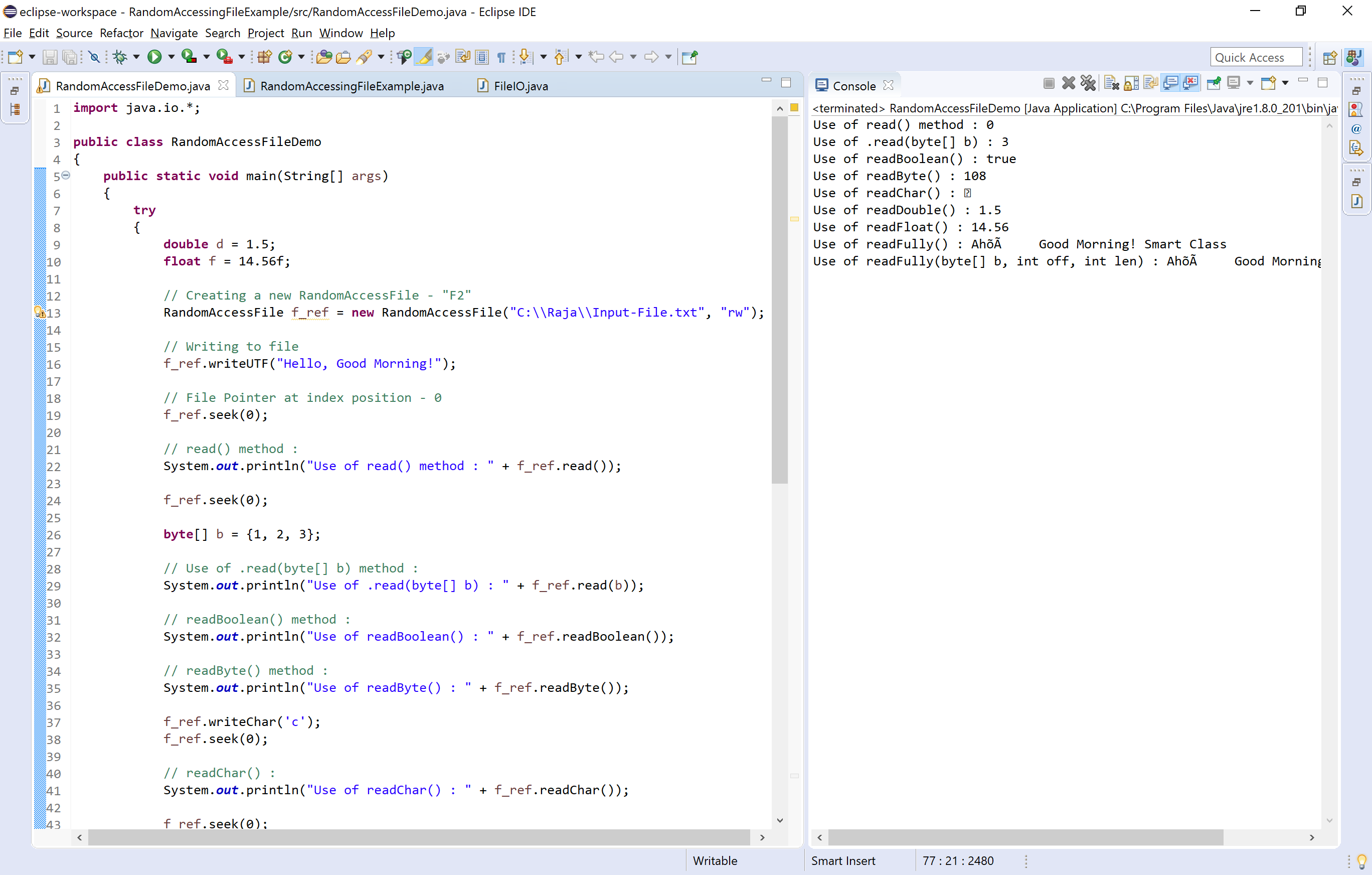RandomAccessFile in Java
In java, the java.io package has a built-in class RandomAccessFile that enables a file to be accessed randomly. The RandomAccessFile class has several methods used to move the cursor position in a file.
A random access file behaves like a large array of bytes stored in a file.
RandomAccessFile Constructors
The RandomAccessFile class in java has the following constructors.
| S.No. | Constructor with Description |
|---|---|
| 1 |
RandomAccessFile(File fileName, String mode)
It creates a random access file stream to read from, and optionally to write to, the file specified by the File argument. |
| 2 |
RandomAccessFile(String fileName, String mode)
It creates a random access file stream to read from, and optionally to write to, a file with the specified fileName. |
Access Modes
Using the RandomAccessFile, a file may created in th following modes.
- r - Creates the file with read mode; Calling write methods will result in an IOException.
- rw - Creates the file with read and write mode.
- rwd - Creates the file with read and write mode - synchronously. All updates to file content is written to the disk synchronously.
- rws - Creates the file with read and write mode - synchronously. All updates to file content or meta data is written to the disk synchronously.
RandomAccessFile methods
The RandomAccessFile class in java has the following methods.
| S.No. | Methods with Description |
|---|---|
| 1 |
int read()
It reads byte of data from a file. The byte is returned as an integer in the range 0-255. |
| 2 |
int read(byte[] b)
It reads byte of data from file upto b.length, -1 if end of file is reached. |
| 3 |
int read(byte[] b, int offset, int len)
It reads bytes initialising from offset position upto b.length from the buffer. |
| 4 |
boolean readBoolean()
It reads a boolean value from from the file. |
| 5 |
byte readByte()
It reads signed eight-bit value from file. |
| 6 |
char readChar()
It reads a character value from file. |
| 7 |
double readDouble()
It reads a double value from file. |
| 8 |
float readFloat()
It reads a float value from file. |
| 9 |
long readLong()
It reads a long value from file. |
| 10 |
int readInt()
It reads a integer value from file. |
| 11 |
void readFully(byte[] b)
It reads bytes initialising from offset position upto b.length from the buffer. |
| 12 |
void readFully(byte[] b, int offset, int len)
It reads bytes initialising from offset position upto b.length from the buffer. |
| 13 |
String readUTF()
t reads in a string from the file. |
| 14 |
void seek(long pos)
It sets the file-pointer(cursor) measured from the beginning of the file, at which the next read or write occurs. |
| 15 |
long length()
It returns the length of the file. |
| 16 |
void write(int b)
It writes the specified byte to the file from the current cursor position. |
| 17 |
void writeFloat(float v)
It converts the float argument to an int using the floatToIntBits method in class Float, and then writes that int value to the file as a four-byte quantity, high byte first. |
| 18 |
void writeDouble(double v)
It converts the double argument to a long using the doubleToLongBits method in class Double, and then writes that long value to the file as an eight-byte quantity, high byte first. |
Let's look at the following example program.
import java.io.*;
public class RandomAccessFileDemo
{
public static void main(String[] args)
{
try
{
double d = 1.5;
float f = 14.56f;
// Creating a new RandomAccessFile - "F2"
RandomAccessFile f_ref = new RandomAccessFile("C:\\Raja\\Input-File.txt", "rw");
// Writing to file
f_ref.writeUTF("Hello, Good Morning!");
// File Pointer at index position - 0
f_ref.seek(0);
// read() method :
System.out.println("Use of read() method : " + f_ref.read());
f_ref.seek(0);
byte[] b = {1, 2, 3};
// Use of .read(byte[] b) method :
System.out.println("Use of .read(byte[] b) : " + f_ref.read(b));
// readBoolean() method :
System.out.println("Use of readBoolean() : " + f_ref.readBoolean());
// readByte() method :
System.out.println("Use of readByte() : " + f_ref.readByte());
f_ref.writeChar('c');
f_ref.seek(0);
// readChar() :
System.out.println("Use of readChar() : " + f_ref.readChar());
f_ref.seek(0);
f_ref.writeDouble(d);
f_ref.seek(0);
// read double
System.out.println("Use of readDouble() : " + f_ref.readDouble());
f_ref.seek(0);
f_ref.writeFloat(f);
f_ref.seek(0);
// readFloat() :
System.out.println("Use of readFloat() : " + f_ref.readFloat());
f_ref.seek(0);
// Create array upto geek.length
byte[] arr = new byte[(int) f_ref.length()];
// readFully() :
f_ref.readFully(arr);
String str1 = new String(arr);
System.out.println("Use of readFully() : " + str1);
f_ref.seek(0);
// readFully(byte[] b, int off, int len) :
f_ref.readFully(arr, 0, 8);
String str2 = new String(arr);
System.out.println("Use of readFully(byte[] b, int off, int len) : " + str2);
}
catch (IOException ex)
{
System.out.println("Something went Wrong");
ex.printStackTrace();
}
}
}
When we run the above program, it produce the following output.

